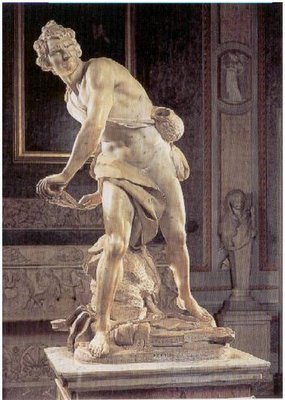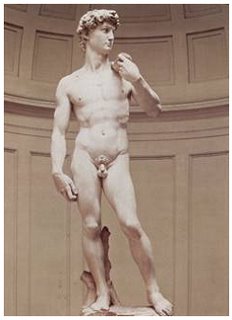Today I want to tell you a story of two Davids, made by two artists, produced in two different artistic periods. One David was a thinker; the other a brute. The difference explains the difference between the Renaissance and the Baroque periods, and the two artists.
 The chief artistic difference between the Renaissance period and the Baroque period that followed it was the difference between learning and applying. Come the Renaissance and for the first time in centuries, classical technique had been rediscovered and the masters of the Renaissance used it produce figures representing ideal men instead of metaphysical waifs, and art that glorified this earth rather than some other dimension. It was the most important artistic turning point of the last two-thousand years.
The chief artistic difference between the Renaissance period and the Baroque period that followed it was the difference between learning and applying. Come the Renaissance and for the first time in centuries, classical technique had been rediscovered and the masters of the Renaissance used it produce figures representing ideal men instead of metaphysical waifs, and art that glorified this earth rather than some other dimension. It was the most important artistic turning point of the last two-thousand years.
Standing on the shoulders of those making this rediscovery were the later Baroque masters, who made the most of the lessons learned to do something quite new in artistic history. What the classicists and the Renaissance masters had done was to produce idealised figures, but they were figures without motion. That was what the Baroque masters added.
In the Baroque, for the first time in art, we see dramatic movement, great power, intense emotion; the expression of each of these became possible to the artists in the Baroque period because of the lessons learned earlier by the Renaissance masters.

 These two great statues of David that are separated by just over a century give the lesson. In Michelangelo’s famous depiction of the great Biblical hero, above and right, he fuses classicism with Florentine humanism. Selecting the psychologically-charged moment of calm -- the centre of the storm just before battle -- he depicts the moment of decision, the act of mind that won the battle of boy against giant.
These two great statues of David that are separated by just over a century give the lesson. In Michelangelo’s famous depiction of the great Biblical hero, above and right, he fuses classicism with Florentine humanism. Selecting the psychologically-charged moment of calm -- the centre of the storm just before battle -- he depicts the moment of decision, the act of mind that won the battle of boy against giant.
Bernini however, at left and below, shows something quite different. For his piece he chooses the moment of action; the instant in which the battle is joined.
Where Michelango's David of 1501-04 is static, suggesting the later movement rather than showing it, Bernini's of i623-24 is all motion, all power, and displays the inner emotional intensity of the shepherd-warrior.
Motion and purpose, fused with emotion - all the very real essentials of life; this fusion was the leitmotif of the very best of Baroque expression.


3 comments:
DAvid has that same "look" that Carter gives before he kicks at goal.
SHould we rename Carter the Rugby Renaissance Man?
So he does. Astonishing. :-)
It's a supremely confident "I know I can take you" look, isn't it.
Post a Comment